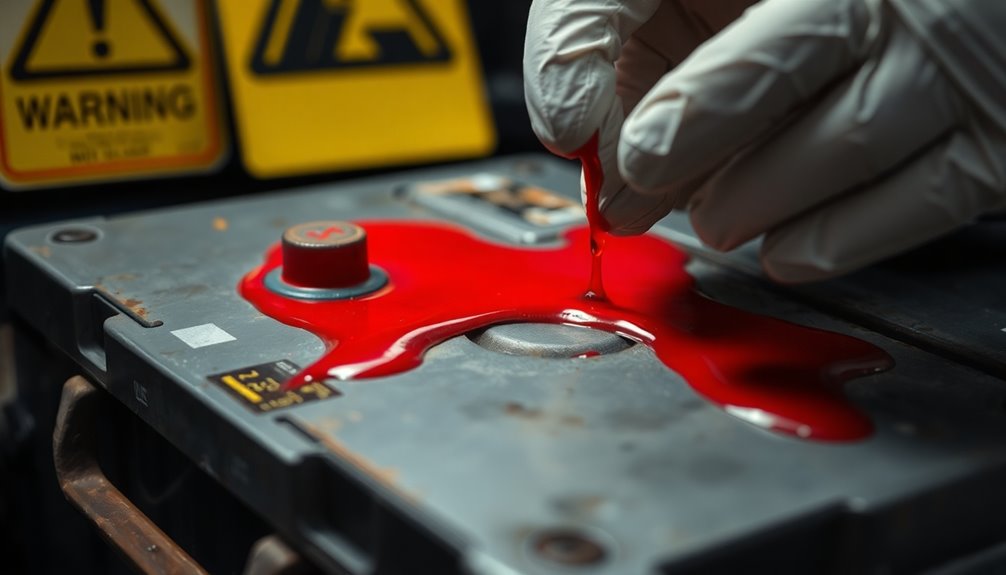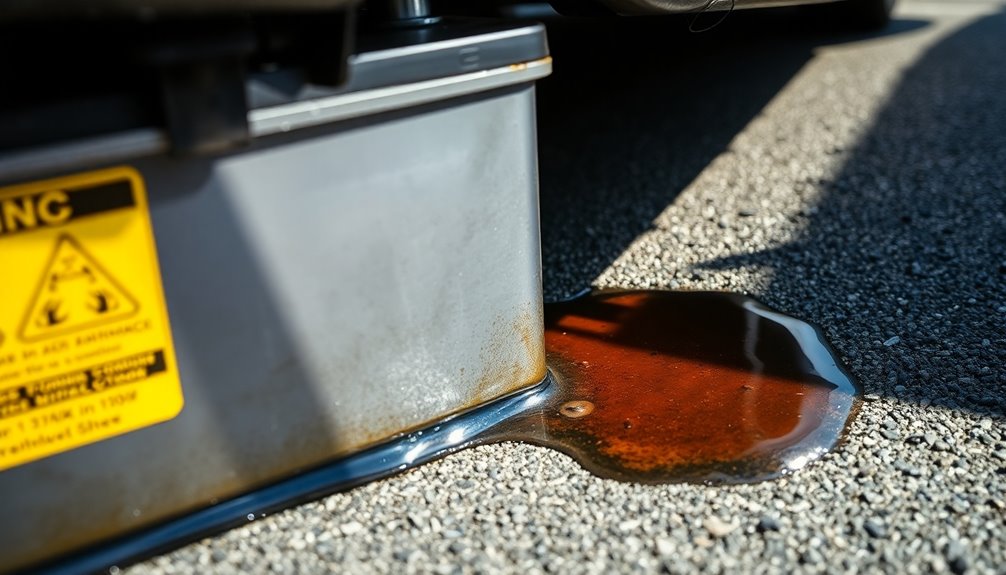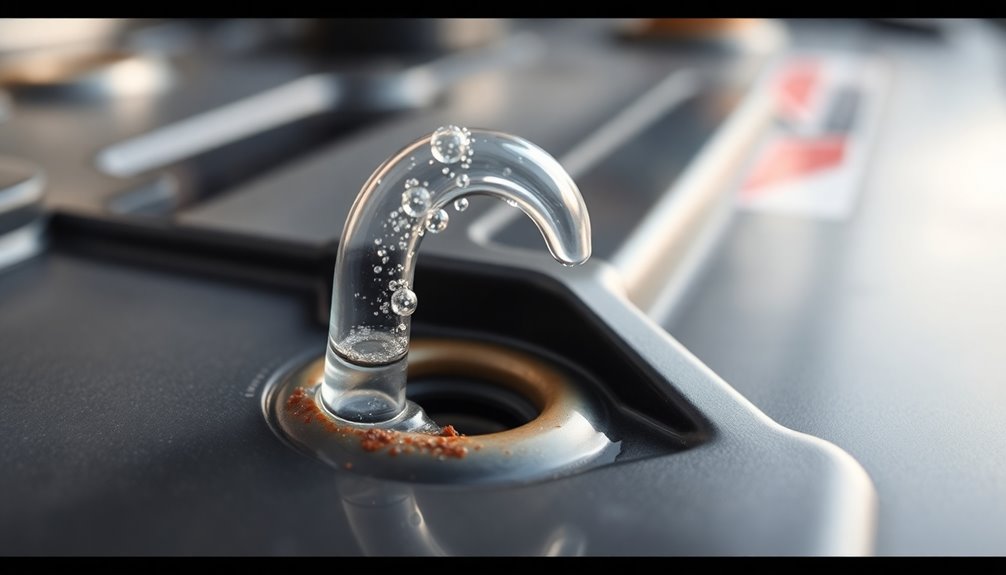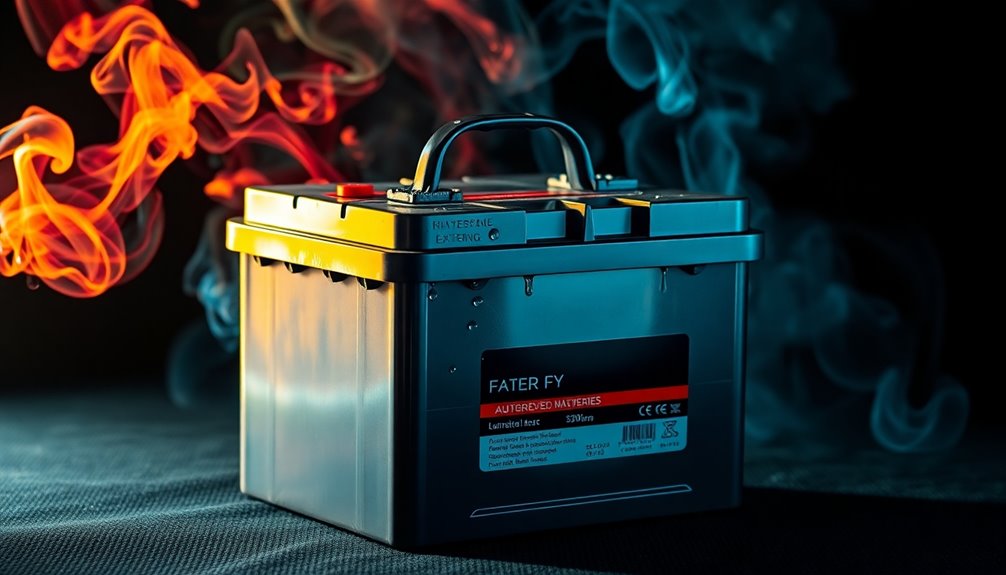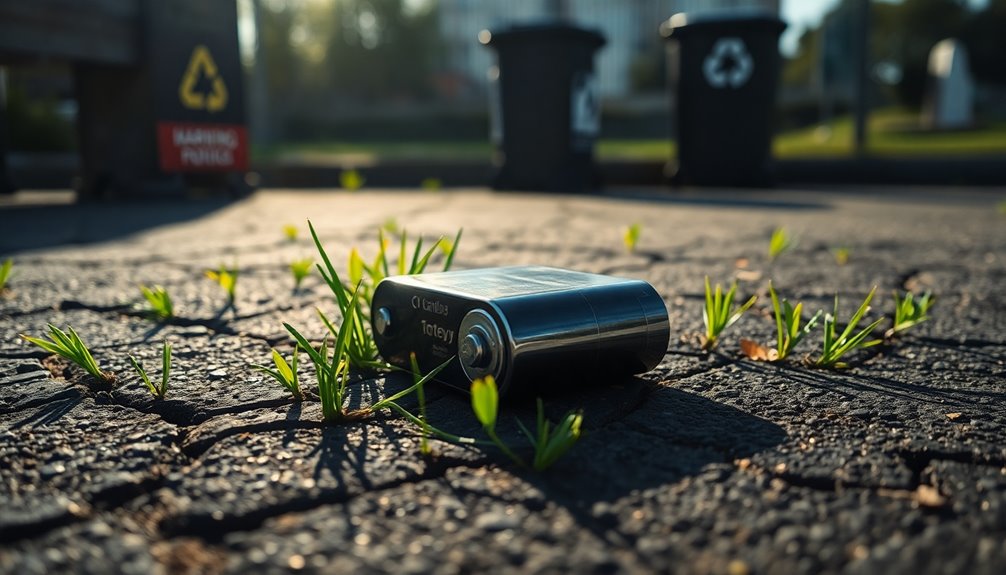If you see red fluid leaking from your car battery, act quickly to ensure safety. First, wear protective gloves and goggles to avoid contact with battery acid. Turn off the engine and disconnect the negative terminal, followed by the positive one. Clean up any spills using a baking soda solution to neutralize the acid. Inspect the battery for cracks or corrosion. If it's older than five years or visibly damaged, consider replacing it. Dispose of the old battery properly at a recycling center. For further details on safe handling and disposal, you might want to explore more.
Key Takeaways
- Wear protective gloves and eyewear to avoid skin and eye contact with acid leaks.
- Disconnect the battery immediately, starting with the negative terminal to prevent sparks.
- Neutralize any spilled acid with a baking soda paste to prevent further damage.
- Securely store the leaking battery upright and transport it to a certified recycling center.
- Avoid driving the vehicle and contact a professional for assistance with the leak.
Identify the Leak Source
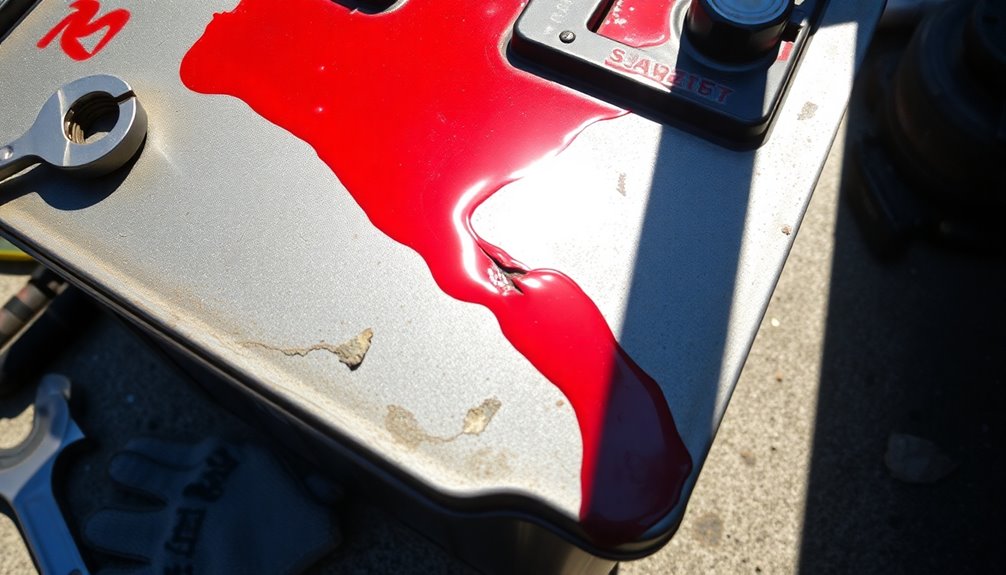
Identifying the source of a leak in your car battery is crucial to preventing further damage and ensuring safety.
Start by inspecting the battery case for cracks, which can occur due to overheating, age, or physical damage. If you notice any bloating or warping, that's a strong indication of internal damage or short-circuits.
Next, check the rubber seals around the battery terminals. If they're compromised, acid and fumes might be leaking.
You should also monitor fluid levels; low levels can signal a leak. Look for signs of corrosion, like white powder around the terminals, which can indicate acid leakage. If you catch any sulfur-like odors, that's another red flag. Regular checks of battery condition can help you spot corrosion issues early.
Additionally, consider the battery's age; those over five years are more susceptible to leaks.
Don't overlook external factors, too. A malfunctioning alternator can cause overcharging, leading to leaks.
Regular maintenance checks can help you catch these issues early, saving you from bigger problems down the road. By systematically assessing these areas, you'll be better equipped to pinpoint the source of any leaks.
Ensure Personal Safety
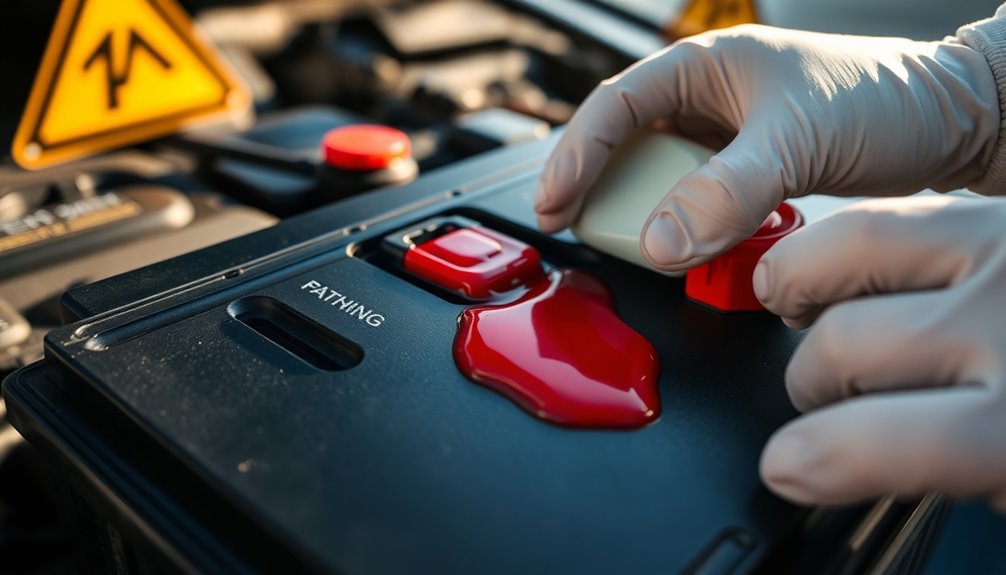
When dealing with a leaking car battery, prioritizing your personal safety is essential. Start by wearing protective gloves to shield your skin from the acid.
It's also crucial to use protective eyewear or goggles to guard against any acid splashes. Ensure that your gear is acid-resistant to effectively handle corrosive materials, and cover any exposed skin and clothing to minimize the risk of spills. If available, use a face mask to prevent inhaling harmful fumes.
Avoid touching the leaked acid with bare hands and refrain from moving the leaking battery unless absolutely necessary. Always handle the battery in a well-ventilated area to reduce inhalation risks, and make sure the engine and all electrical components are turned off before proceeding.
Use acid-resistant containers or absorbent materials to contain any leaks. It's important to note that overcharging leads to excess electricity entering the battery, which can also contribute to leaks.
If you need to neutralize the acid, mix baking soda with water to create a safe solution. Apply this solution carefully to the affected areas, avoiding water alone as it can spread the acid.
Remember to wash your skin immediately with cold water if it makes contact with the acid, and flush your eyes thoroughly if necessary.
Disconnecting the Battery

How do you safely disconnect a leaking car battery?
First, locate your battery by checking the owner's manual. It's often under the hood, but it could be in the trunk or under the rear seat. Make sure the hood is securely raised and check for any safety catches.
Once you've found the battery, identify the terminals. The positive terminal, marked with a "+", usually has a red cable, while the negative terminal, marked with a "-", has a black cable. Remove any plastic caps covering the terminals for better access.
To disconnect the battery, start by turning off the engine and removing the keys from the ignition. Use a wrench to loosen the nut securing the negative terminal. Carefully lift the negative cable off the battery post and set it aside, ensuring it's far out of the way to prevent accidental contact. It's important to remember that the negative battery cable should always be disconnected first.
Next, loosen the bolt on the positive terminal. Wrap the positive cable end with non-conductive material to avoid it touching any metal. Lift the positive cable off the battery post and set it aside, making sure the terminals don't touch each other or any metal surfaces.
Cleaning Up the Spill

Often, cleaning up a spill from a leaking car battery requires prompt action to prevent further damage and ensure safety. Start by neutralizing any corrosion. Mix baking soda with water to create a paste, and apply it to the corroded areas. Watch for fizzing and bubbling; this means the solution is working. Once it stops, rinse the area with clean water, but be careful not to let the solution leak into the battery cells.
Next, clean the battery terminals. Use a wire brush or scraper to remove solid corrosion. Dip the terminal ends in your baking soda solution or use a commercial cleaner. Scrub until all debris is gone, then rinse and dry the terminals with a microfiber cloth. Regular inspection can help identify battery corrosion early, which is essential for maintenance.
For the spilled acid, cover the area generously with baking soda until it stops fizzing. Use shop towels or a plastic shovel to collect the neutralized acid and contaminated materials, placing them into separate bags for disposal.
Seal all contaminated items, including gloves, in bags. Finally, clean the area thoroughly to prevent further corrosion or damage, ensuring your workspace is safe and clean.
Inspecting for Damage
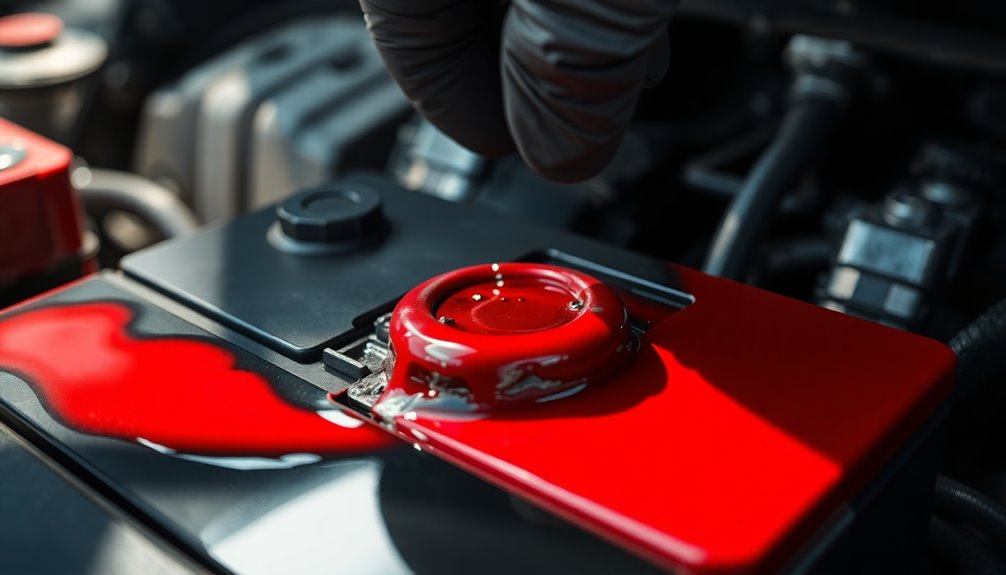
Inspecting for damage is crucial after discovering a car battery leaking red fluid. Start with a visual inspection of the battery. Look for any swollen or bloated casing, which indicates internal gas build-up. Check for cracks, bulges, or splits in the battery casing that might point to serious issues.
Pay attention to the battery terminals as well; any white or bluish-green powdery residue signals corrosion, while wet areas or a sweating appearance could indicate leaks. Additionally, be aware that visible damage such as cracks or bulges can be red flags for leaks.
Next, examine the battery terminals closely. Look for abnormal buildup around the terminal caps and inspect them for damage or loose connections. Be wary of any strong sulfuric acid odors, which suggest acid leakage. Ensure the terminal caps are secure and intact.
Don't forget about the battery fluid levels and vent caps. Regularly check fluid levels to see if they're above the battery plates and ensure vent caps are secure to prevent evaporation.
Lastly, monitor voltage readings with a voltmeter. Fluctuating or low readings may indicate a leak, so keep an eye out for electrical issues like dimming headlights or starting problems.
Determine the Cause
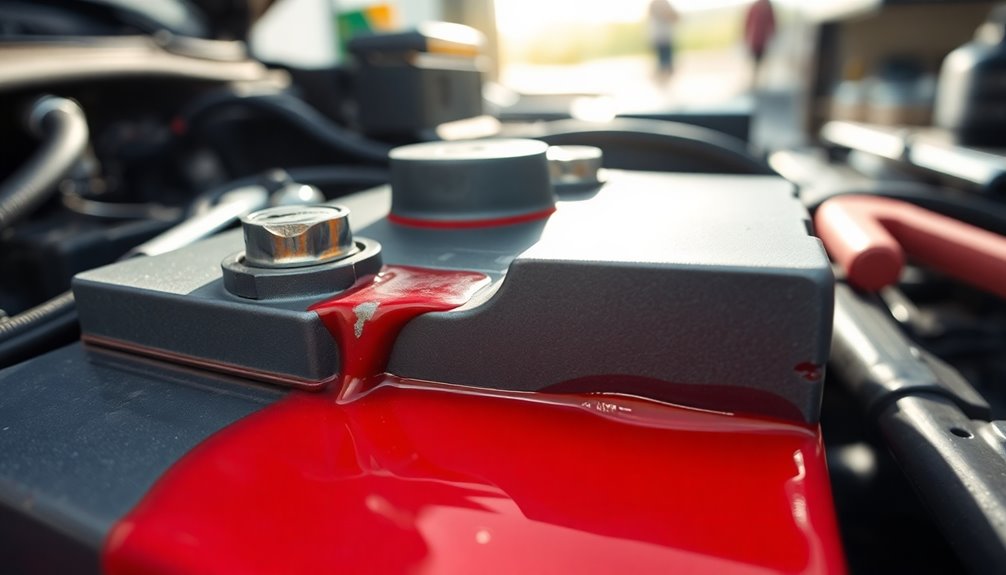
After identifying damage during your inspection, it's important to determine the cause of the red fluid leak from your car battery. Start by checking the battery hold-down and mounting. A loose or damaged hold-down can let the battery move, leading to friction and leaks. If you notice any wear or bending in the hold-down, secure or replace it to prevent further damage.
Next, examine the battery sensor and charging system. A faulty battery sensor can cause incorrect temperature readings, leading to overcharging. Overcharging can heat the battery, resulting in leaks, so ensure the alternator and voltage regulator are functioning properly. Additionally, a malfunctioning voltage regulator may trigger warning lights that indicate potential issues with the battery.
Internal battery damage is another possible culprit. Look for signs of internal short-circuits, which can cause the battery case to bloat and crack. Regular charging practices can help prevent sulfation and damage.
Finally, inspect the battery case and terminals. A cracked case or worn seals can lead to acid leaks. Corrosion around the terminals can also disrupt electrical current. Cleaning the terminals and conducting regular inspections can help identify issues early, keeping your battery safe and functional.
Reinstalling the Battery
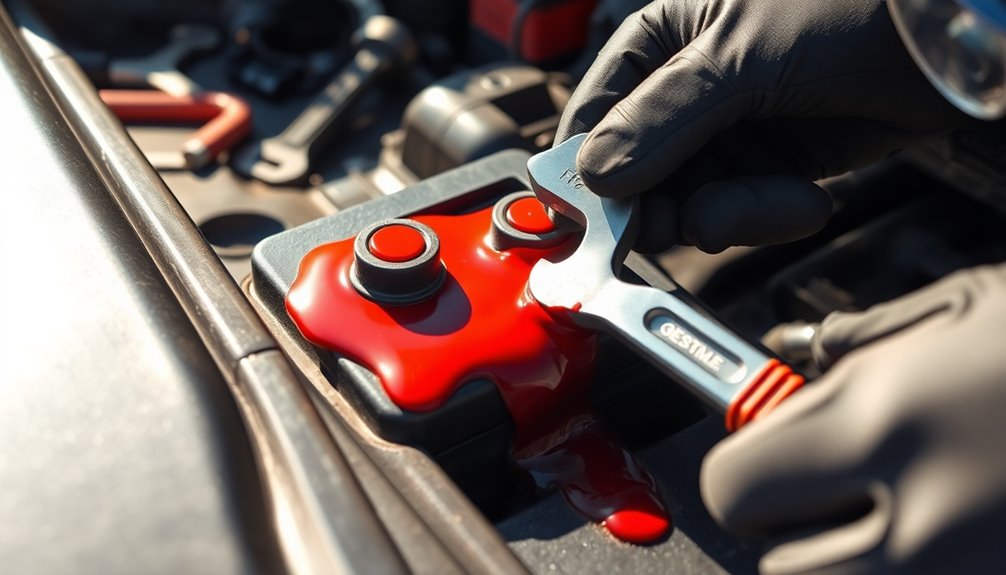
When you're ready to reinstall the battery after addressing the leak, it's essential to follow a careful procedure to ensure safety and functionality.
Start by parking your vehicle on a dry, flat surface with the parking brake engaged. If you recently drove, turn off the engine and let the vehicle cool down. Always wear safety goggles and gloves to protect yourself. It's crucial to ensure the ignition is off before beginning the installation process.
Begin by removing the old battery, disconnecting the negative cable first, followed by the positive cable. Carefully pull the battery out and inspect the tray and terminals for any corrosion.
Next, clean the terminals and tray if necessary. Now, position the new battery in the tray, ensuring it's facing the correct direction and secured with the hold-down clamp.
Connect the positive cable first, tightening it snugly, then connect the negative cable and do the same. To prevent corrosion, apply battery washers and some dielectric grease to the terminals.
Finally, check all connections and hold-downs to make sure they're secure. Test your vehicle by starting the engine to confirm that the new battery works correctly.
Safety and proper installation are key for optimal performance!
Proper Battery Disposal
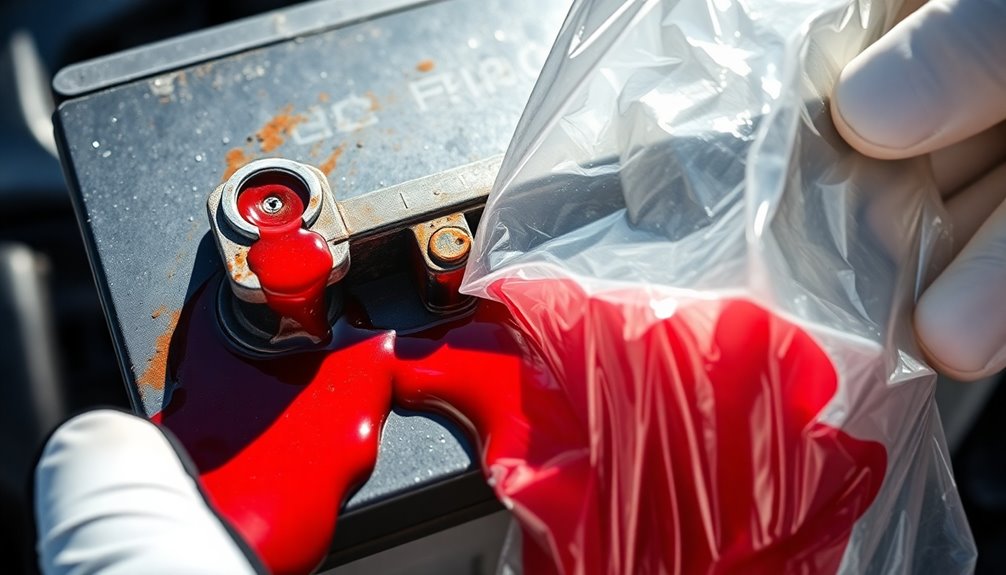
Once you've successfully installed your new battery, it's important to think about how to dispose of the old one properly. First, take the old battery to a certified recycling center or return it to an automotive shop that offers recycling services. Many retailers also accept used batteries when you purchase a new one, often providing a discount or core charge refund. Certified recycling centers ensure that hazardous materials are safely dismantled and recycled, minimizing environmental risks.
Before transporting your old battery, make sure it's removed and stored upright to prevent any acid leaks. Wear proper personal protective equipment, and inspect the battery for dents or leaks. Keep it away from other hazardous materials to avoid contamination.
If you encounter a leaking battery, contact roadside assistance or a professional mechanic for safe handling.
Improper disposal can have severe environmental consequences, contaminating soil, water, and air with lead and sulfuric acid. Remember, it's illegal to throw car batteries in the trash, so adhere to your local laws regarding battery disposal.
Frequently Asked Questions
Can a Leaking Battery Explode?
Yes, a leaking battery can explode.
When batteries leak, they often release flammable hydrogen gas, which can ignite if it comes into contact with sparks or flames.
If you're in a confined space, the risk of explosion increases as gas accumulates.
It's crucial to act quickly; avoid any ignition sources and seek professional help immediately to prevent potential hazards.
Always prioritize safety when dealing with battery leaks to avoid severe consequences.
What Are the Symptoms of Battery Acid Exposure?
If you've been exposed to battery acid, you might experience severe symptoms.
Swallowing it can cause throat burns and difficulty breathing. If you inhale fumes, look out for bluish skin and chest pain.
Skin contact leads to burning and painful drainage, while eye exposure could result in vision loss and intense pain.
It's crucial to recognize these signs quickly, as they can lead to serious health complications if not addressed immediately.
How Do I Safely Transport a Leaking Battery?
To safely transport a leaking battery, first wrap it in thick cloth to absorb any acid.
Secure the cloth with duct tape, then place the battery in a box, ensuring it sits upright.
Pack newspaper around it for stability and seal the box.
Wear gloves and goggles, and keep the battery away from flames.
Label the box as "Fragile" and "This Side Up" to ensure careful handling during transport.
How Often Should I Check My Car Battery?
You should check your car battery at least every six months or every 6,000 miles to ensure it's in good shape.
It's a good idea to have an annual check-up by a certified technician.
Keep an eye out for signs like slow engine cranks, corrosion, or warning lights, as these indicate it's time for a closer look.
Regular visual inspections can also help you catch potential issues before they escalate.
What Should I Do if Battery Fluid Contacts Skin?
If battery fluid contacts your skin, act quickly!
First, flush the area with cool or lukewarm water for 15-30 minutes.
Remove any contaminated clothing and jewelry to prevent further exposure.
Neutralize the acid using a baking soda and water solution if it's sulfuric acid.
If symptoms persist, seek medical attention immediately.
Remember, it's crucial to identify the type of battery acid for appropriate treatment.
Stay safe and keep emergency contacts handy!
Conclusion
In conclusion, if you notice red fluid leaking from your car battery, it's crucial to act quickly and safely. Start by identifying the leak source and ensuring your personal safety. Disconnect the battery and clean up any spills. Inspect for damage and determine the cause before reinstalling or disposing of the battery properly. Taking these steps helps protect you and your vehicle, ensuring you can get back on the road with peace of mind.

